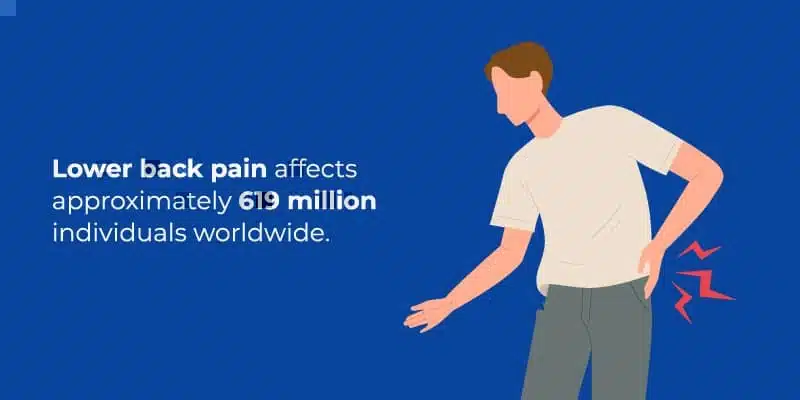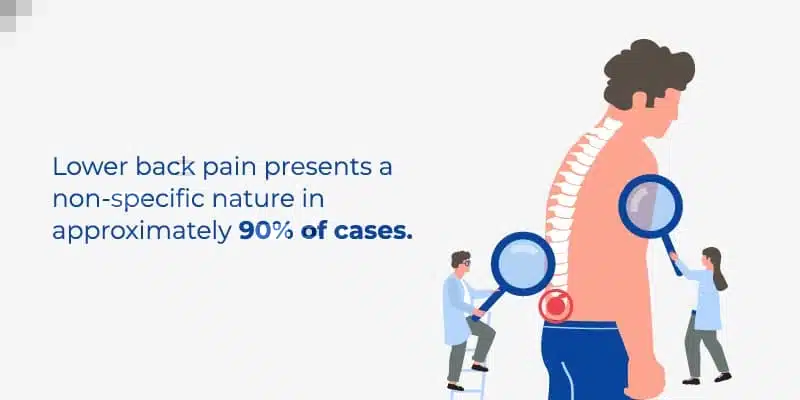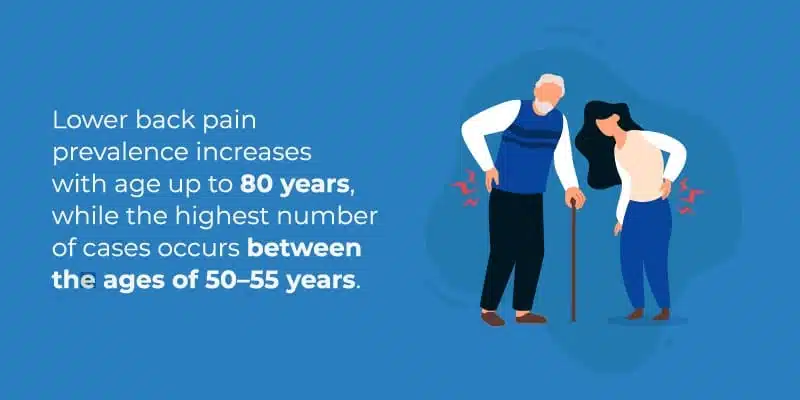
Effective Strategies for Chronic Lower Back Pain Treatment
Learn more about different types of chronic lower back pain treatment and how to get the help you need here.
Table of Contents
Introduction
Pain is a global issue, with a growing number of individuals developing and enduring various forms of pain. One of the prevalent manifestations is chronic lower back pain.
Understanding the treatment for chronic lower back pain has become a crucial healthcare focus due to its widespread occurrence and substantial impact on quality of life.
However, addressing chronic lower back pain necessitates an examination of its underlying causes.
What to Expect from This Article
In this article, we’ll be looking at what chronic lower back pain is and why it occurs. Next, we’ll consider several different chronic lower back pain treatment options.
We’ll also be taking a look at the potential benefits and risks of medication-based chronic lower back pain treatments. Finally, we’ll consider how J. Flowers Health Institute can help you treat and manage the symptoms of this condition.

What is Chronic Lower Back Pain?
Chronic lower back pain is a common, often debilitating, condition. It’s characterized by a persistent ache or discomfort in the lower part of the back.
The term “chronic” signifies that the pain lasts for twelve weeks or longer. That is, it remains even after the initial injury or cause of the acute lower back pain has been treated.1
It’s important to note that chronic lower back pain is not only a prolonged state of acute pain. Rather, it often involves distinct pathophysiological processes. As such, it is often more challenging to manage and treat.
Anatomy of the Back
The human back is a complex structure composed of bones, joints, ligaments, and muscles. Pain can result from:
- Strained muscles or ligaments
- Ruptured discs
- Irritated joints
- Diseases that impact these structures
Understanding the cause of chronic lower back pain will often require a comprehensive medical evaluation. This is because the origins can be varied and, in some cases, may be difficult to pinpoint.
How Does This Pain Manifest?
Chronic lower back pain can manifest in various forms. It can be a constant dull ache, a sharp localized pain, or even a radiating discomfort that descends down the legs.
Causes of Chronic Lower Back Pain
Chronic lower back pain can be attributed to a multitude of causes. These can be broadly categorized into the following classes:
- Mechanical or musculoskeletal causes
- Non-mechanical spinal conditions
- Referred pain from other organs
- Systemic conditions
- Psychosocial factors
Mechanical or Musculoskeletal Causes
- Degenerative disc disease
- Herniated or ruptured discs
- Radiculopathy
- Spinal stenosis
- Spondylolisthesis
- Musculoskeletal strain
Non-Mechanical Spinal Conditions
These are conditions not directly related to the mechanical structure of the spine.
Examples include:
- Tumors
- Infections
- Inflammatory diseases
Referred Pain
This is pain perceived in the lower back but originating from other organs.
Examples include:
- Kidney stones or kidney infections
- Gynecological disorders
- Abdominal aortic aneurysms
Systemic Conditions
These are diseases that affect multiple organs or the entire body. Examples include:
- Fibromyalgia
- Chronic fatigue syndrome
Psychosocial Factors
Mental health and social factors can influence the perception of pain. Examples of mental health conditions that can affect pain perception include:
- Depression
- Anxiety
- Work dissatisfaction
- Stress
Effective Chronic Lower Back Pain Treatment Options
Chronic lower back pain can be a challenging condition to live with. It often affects daily life, from standing and sitting to sleeping. It’s vital to know the range of chronic lower back pain treatment options available.
These treatments help manage the symptoms and improve the quality of life. These options can be broadly divided into conservative (non-surgical) and surgical treatments.
Physical Therapy
This is often the first line in chronic lower back pain treatment. Physical therapists can teach exercises that improve flexibility, strength, core, and stability.
These exercises also help increase the range of motion. This not only helps reduce current pain but also can prevent future episodes.
Physical therapists may use techniques like:3
- Heat or cold therapy
- Ultrasound
- Electrical stimulation
- Taping
Medication
Several medications can be used in chronic lower back pain treatment. Over-the-counter nonsteroidal anti-inflammatory drugs (NSAIDs) like ibuprofen can help manage pain and inflammation.
Additionally, prescription drugs like muscle relaxants, antidepressants, and anticonvulsant drugs may also be used.
Opioids are sometimes prescribed for severe pain. But, they should be used with caution due to the risk of dependency.
Lifestyle Changes
Lifestyle changes are often crucial aspects of managing and mitigating the symptoms of chronic pain.
Lifestyle changes may include:
- Maintaining a healthy weight
- Quitting smoking
- Reducing stress
- Practicing good posture
Regular low-impact exercises such as walking, swimming, and cycling can also be beneficial.
Complementary and Alternative Medicine
This includes techniques like:
- Acupuncture
- Massage
- Spinal manipulation
These techniques can be effective chronic lower back pain treatments for some patients. Yoga and mindfulness-based stress reduction can also help by improving flexibility and reducing stress.
Cognitive Behavioral Therapy (CBT)
Chronic lower back pain isn’t just physical; it can also affect mental health. CBT can help people manage their pain better by changing the way they perceive it.
What is CBT?
Interventional Procedures
Conservative chronic lower back pain treatments aren’t always effective. When they fail, procedures like nerve blocks and epidural steroid injections can be considered.
These treatments work by reducing the inflammation around the nerves. They may also work by interrupting the pain signals from the nerves to the brain.
Surgery
Surgery is often considered a last resort in the chronic lower back pain treatment plan. It’s often reserved for cases where other treatments have failed, and the pain is severe and debilitating.
Surgical options can include discectomy, laminectomy, or spinal fusion. The specific surgery depends on the cause of the pain, such as a herniated disc, spinal stenosis, or spondylolisthesis.
The best chronic lower back pain treatment approach often involves a combination of different methods. These methods are often tailored to the individual patient’s needs and lifestyle.

Potential Benefits and Risks of Medication-Based Chronic Lower Back Pain Treatment
Medication-based treatments can play a pivotal role in chronic lower back pain treatment. But, medication-based chronic lower back pain treatment has both potential benefits and risks. These all need to be understood before starting the therapy.
Non-Steroidal Anti-Inflammatory Drugs (NSAIDs)
This includes drugs like ibuprofen and naproxen.
Benefits
Risks
Long-term use or high doses can lead to gastrointestinal problems like ulcers, bleeding, or perforation.
NSAIDs can also increase the risk of heart attacks and stroke, especially in people with pre-existing heart conditions. Kidney damage is another risk with prolonged usage.
Acetaminophen (Paracetamol)
It’s often used in chronic lower back pain treatment as a first-line medication. It is especially preferred if the pain is not accompanied by inflammation.
Benefits
Acetaminophen can effectively reduce pain. It is often safe for most people when used at recommended doses.
Risks
It can cause liver damage if taken in large doses or for a long time. Alcohol consumption during its use might increase this risk.
Muscle Relaxants
These get prescribed in chronic lower back pain treatment for short-term relief from muscle spasms.
Benefits
Muscle relaxants can help reduce pain and discomfort caused by muscle spasms or tension. They can also improve mobility.
Risks
They can cause side effects like drowsiness, dizziness, and dependence with long-term use. It’s often recommended for short-term usage.
Opioids
Opioids are used as a chronic lower back pain treatment for severe pain when other treatments are ineffective.
Benefits
Opioids can provide significant pain relief for severe chronic lower back pain. This improves quality of life.
Risks
They come with a high risk of dependency and addiction. Side effects include:
- Constipation
- Drowsiness
- Nausea
- Increased sensitivity to pain
Long-term use may lead to opioid use disorder.
Antidepressants and Anticonvulsants
Some antidepressants and anticonvulsants can be effective in chronic lower back pain treatment. This is particularly so when the pain is related to nerve damage.
Benefits
They can help manage nerve pain and improve sleep. Certain antidepressants also have a muscle relaxant effect.
Risks
Side effects can include drowsiness, dizziness, and weight gain. In some cases, they can lead to suicidal thoughts or behaviors.
Corticosteroids
These can be used as part of chronic lower back pain treatment. They are often delivered through an injection to the affected area.
Benefits
Steroids can reduce inflammation and provide significant pain relief. They are especially useful when the pain is due to conditions like herniated discs or spinal stenosis.
Risks
Potential side effects include:
- Elevated blood sugar levels
- Fluid retention
- Suppression of the body’s natural steroid production
Repeated steroid injections may weaken spinal bones and nearby muscles.

The Role of Heat or Cold Therapy in Chronic Lower Back Pain Treatment
Heat and cold therapy are common, non-invasive, and often the first line of treatment for chronic lower back pain. Both therapies work differently and can help reduce pain in different ways.
Heat Therapy for Chronic Lower Back Pain Treatment
Heat therapy works by improving circulation and blood flow to a particular area due to increased temperature. This not only accelerates the healing process by bringing nutrients to the damaged tissue but also can help soothe discomfort and relieve muscle tension.
Benefits of Heat Therapy
Below are some of the benefits of heat therapy.
Muscle Relaxation
Heat can relax tense muscles and heal damaged tissues. This is beneficial in chronic lower back pain treatment, where pain often stems from muscle tension or spasms.
Increased Flexibility
By relaxing the muscles, heat therapy can also improve flexibility and mobility, allowing individuals to move more comfortably.
Improved Circulation
Heat causes blood vessels in the treated areas to expand. This increases the flow of oxygen and nutrients and helps heal damaged muscle tissues.
Methods of Applying Heat Therapy
Methods of applying heat therapy include:
- Hot water bottles
- Heating pads
- Heat wraps
- Warm baths or hot showers
Cold Therapy for Chronic Lower Back Pain Treatment
Cold therapy is also known as cryotherapy. It works by reducing blood flow to a particular area.
Benefits of Cold Therapy
Below are some of the benefits of cold therapy.
Reduced Inflammation
Cold therapy can help minimize inflammation and swelling. This, in turn, reduces pain. This is particularly helpful after acute injury or a flare-up of chronic lower back pain.
Numbing Effect
Cold can numb sore tissues, acting as a local anesthetic, and interrupt pain signals to the brain.
Muscle Spasm Reduction
Cold therapy can also help reduce muscle spasms, a common cause of lower back pain.
Methods of Applying Cold Therapy
Methods of applying cold therapy include:
- Ice packs
- Cooling gel packs
- Cold massage
- Ice baths
When to Use Heat and Cold Therapy
In general, it’s recommended to use cold therapy for the first 24-48 hours following an injury to reduce inflammation. After this period, heat therapy can be used to help with muscle tension and stiffness. But, preferences can vary, and some people find more relief with one versus the other.
It’s important to use both therapies safely. Do not apply heat or cold directly to the skin; instead, wrap the heat or cold source in a towel. Limit applications to 15-20 minute intervals to avoid skin damage.
Heat and cold therapy can be beneficial as part of a comprehensive chronic lower back pain treatment plan. But, they are often used for temporary relief of pain rather than a long-term solution. They work best when combined with other treatments.
An Overview of Heat and Cold Therapy
Latest Advancements in Chronic Lower Back Pain Treatment
The field of chronic lower back pain treatment is continuously evolving. There are several ongoing research and developments leading to innovative therapies. These can help improve patient outcomes and quality of life.
Here are some of the latest advancements in this field:
Regenerative Medicine Therapies
These include the following:
Stem Cell Therapy
This innovative treatment involves the use of stem cells. These have the potential to develop into many different cell types in the body and serve as a repair system.
In the context of chronic lower back pain treatment, stem cells are injected into the painful area. This is done with the aim of:
- Regenerating damaged tissue
- Reducing inflammation
- Promoting healing
Platelet-Rich Plasma (PRP) Therapy
PRP involves the injection of a patient’s own platelets, obtained from their blood, into the painful area. Platelets release growth factors that can promote tissue healing and potentially reduce pain.
Minimally Invasive Spine Surgery
Advances in technology have made surgeries less invasive with quicker recovery times. For example, endoscopic discectomy is a procedure that allows surgeons to remove herniated disc material, causing nerve compression through a small tube. This drastically reduces recovery time.
Radiofrequency Ablation (RFA)
Refinements in RFA technology and technique have led to it becoming a more common treatment for chronic lower back pain.
RFA uses an electrical current produced by a radio wave to heat up a small area of nerve tissue, thereby decreasing pain signals from that specific area.
Spinal Cord Stimulation (SCS)
This involves the implantation of a small device similar to a pacemaker. It delivers low-level electrical signals to the spinal cord or to specific nerves to block pain signals from reaching the brain.
Advances in SCS technology now allow for more targeted stimulation and better pain relief.
High-Intensity Laser Therapy (HILT)
HILT is a non-invasive chronic lower back pain treatment. It uses high-intensity light energy to reduce pain and reduce inflammation. It also uses light energy to stimulate tissue healing and regeneration.

Find Effective Chronic Lower Back Pain Treatment at J. Flowers Health Institute
Are you currently in search of effective chronic lower back pain treatment? Our world-renowned team of experts has the support you need for sustainable recovery.
At J. Flowers Health Institute, we understand just how debilitating chronic lower back pain can be. This is why we offer evidence-based approaches designed to help you heal effectively and thoroughly.
Our Treatment Approach
The chronic lower back pain treatment at J. Flowers Health Institute often includes a combination of conservative treatments like physical therapy, behavioral therapy, and medication management.
We also prioritize the role of psychological well-being in managing chronic lower back pain. We often include cognitive behavioral therapy and mindfulness practices in the treatment plan, focusing on the mind-body connection.
In addition to this, we also offer excellent chronic lower back pain treatment in the best healing-optimized environment. Our team of seasoned specialists will curate a treatment plan that accounts for your unique needs, goals, and lifestyle.
Contact J. Flowers Health Institute Today
Don’t let chronic pain inhibit you from leading the happy, healthy, and fulfilling life you deserve.
Reach out to us today and learn more about our innovative treatment approaches to chronic pain and holistic wellness.
Resources
- https://www.ninds.nih.gov/health-information/disorders/back-pain#:~:text=Chronic%20back%20pain%20is%20pain,back%20pain%20has%20been%20treated.
- https://www.healthline.com/health/low-back-pain-acute#causes
- https://www.hopkinsmedicine.org/health/conditions-and-diseases/back-pain/7-ways-to-treat-chronic-back-pain-without-surgery
- https://www.apa.org/ptsd-guideline/patients-and-families/cognitive-behavioral
- https://www.nhs.uk/conditions/nsaids/#:~:text=Non%2Dsteroidal%20anti%2Dinflammatory%20drugs,painful%20periods
- https://www.urmc.rochester.edu/encyclopedia/content.aspx?contenttypeid=134&contentid=95





